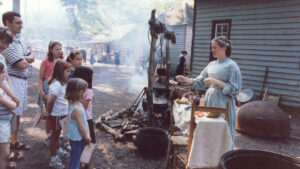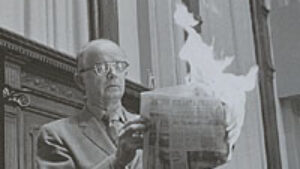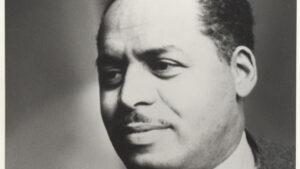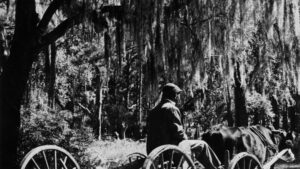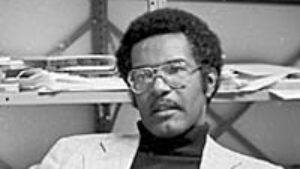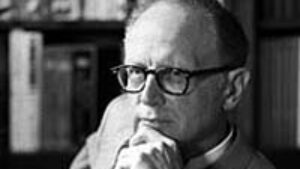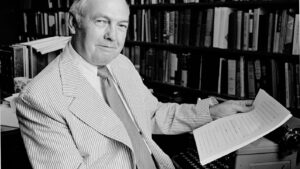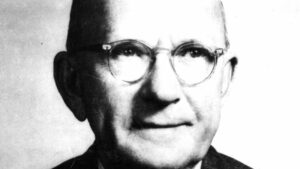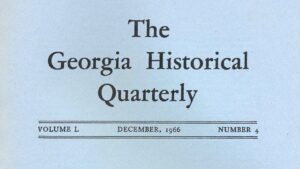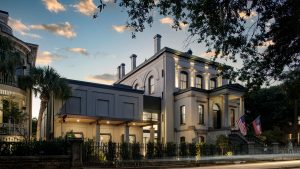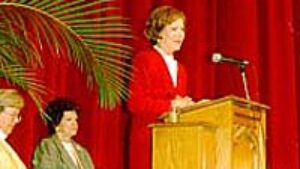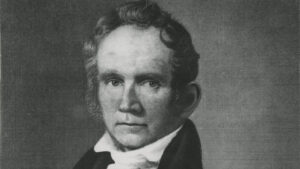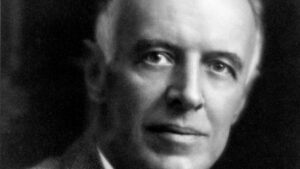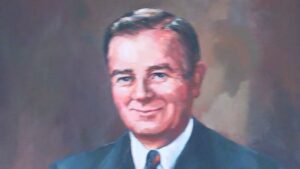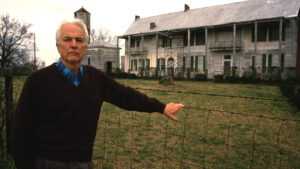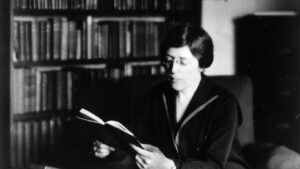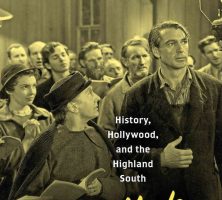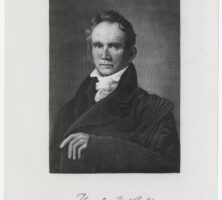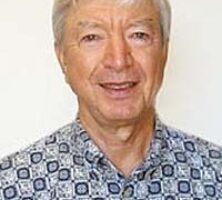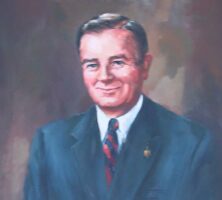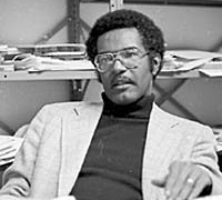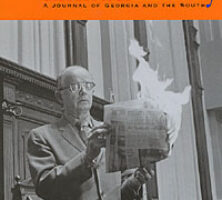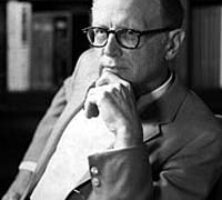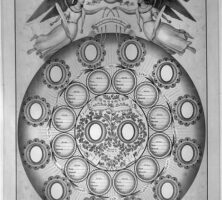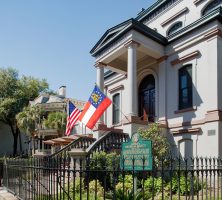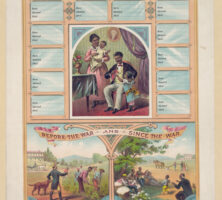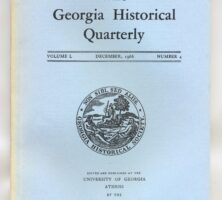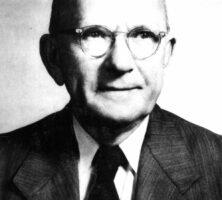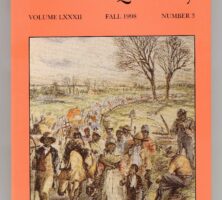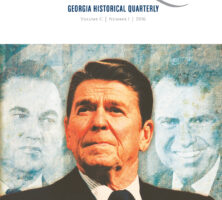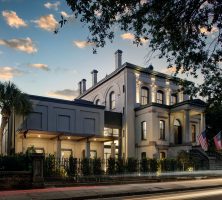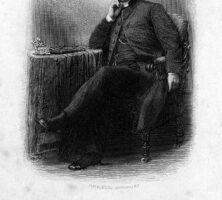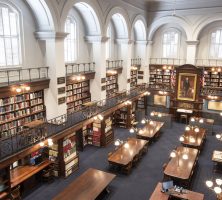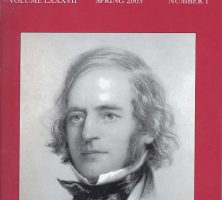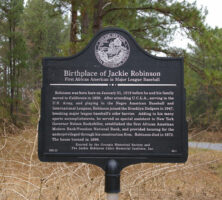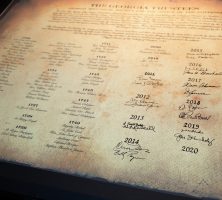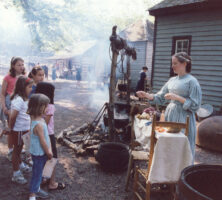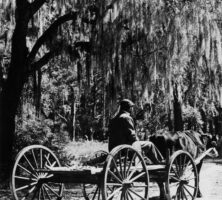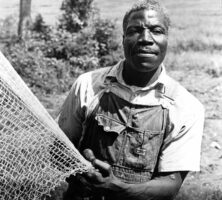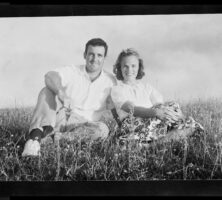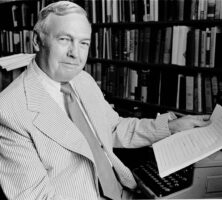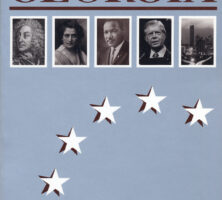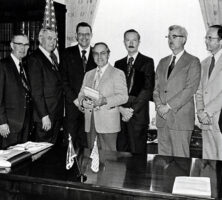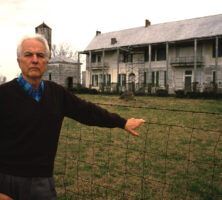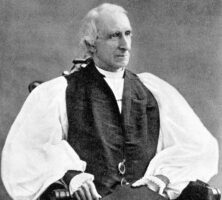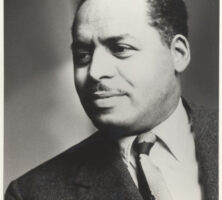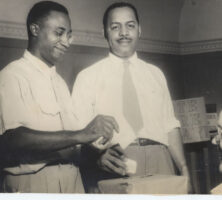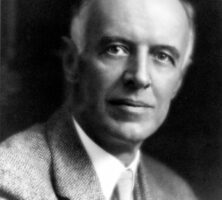The New Georgia Encyclopedia is supported by funding from A More Perfect Union, a special initiative of the National Endowment for the Humanities.
John C. Inscoe is University Professor Emeritus and the Albert B. Saye Professor of History, Emeritus, in the Department of History at the University of Georgia. He has authored several books on Appalachian and southern history and is the founding editor of the New Georgia Encyclopedia.
From the Department of History at the University of Georgia
The New Georgia Encyclopedia does not hold the copyright for this media resource and can neither grant nor deny permission to republish or reproduce the image online or in print. All requests for permission to publish or reproduce the resource must be submitted to the rights holder.
John C. Inscoe, Professor Emeritus at the University of Georgia, taught popular courses including American Lives, Multicultural Georgia, and Appalachia on Film. Those courses later influenced his scholarly works, including Movie-Made Appalachia: History, Hollywood, and the Highland South (2020).
The New Georgia Encyclopedia does not hold the copyright for this media resource and can neither grant nor deny permission to republish or reproduce the image online or in print. All requests for permission to publish or reproduce the resource must be submitted to the rights holder.
Hugh McCall is generally regarded as Georgia's first historian. The first volume of his History of Georgia was published in 1811, and the second in 1816. The two books cover the history of the state from the events leading up to the founding of the colony in 1732 through the state's constitutional convention of 1784.
The New Georgia Encyclopedia does not hold the copyright for this media resource and can neither grant nor deny permission to republish or reproduce the image online or in print. Requests for permission to publish or reproduce the resource should be submitted to the Hargrett Manuscript and Rare Book Library at the University of Georgia.
Edward J. Cashin, a prominent historian of colonial- and Revolutionary-era Georgia, was a professor at Augusta State University for nearly thirty years. He founded the Center for the Study of Georgia History there in 1996 and served as its director until his death in 2007. A prolific writer and researcher, Cashin published more than twenty books over the course of his career and was active in numerous historical organizations around the state.
Courtesy of Augusta State University
The New Georgia Encyclopedia does not hold the copyright for this media resource and can neither grant nor deny permission to republish or reproduce the image online or in print. All requests for permission to publish or reproduce the resource must be submitted to the rights holder.
The New Georgia Encyclopedia does not hold the copyright for this media resource and can neither grant nor deny permission to republish or reproduce the image online or in print. All requests for permission to publish or reproduce the resource must be submitted to the rights holder.
The New Georgia Encyclopedia does not hold the copyright for this media resource and can neither grant nor deny permission to republish or reproduce the image online or in print. All requests for permission to publish or reproduce the resource must be submitted to the rights holder.
A portrait of Albert B. Saye hangs in Demosthenian Hall at the University of Georgia. Saye taught at the university for fifty-five years, until his death in 1989.
Courtesy of the Demosthenian Literary Society
The New Georgia Encyclopedia does not hold the copyright for this media resource and can neither grant nor deny permission to republish or reproduce the image online or in print. All requests for permission to publish or reproduce the resource must be submitted to the rights holder.
John Blassingame, a native of Covington, was a noted historian of slavery. He received his bachelor's degree at Fort Valley State College in Peach County, and completed graduate work at Howard University and Yale University, where he joined the faculty in 1971. His major work, The Slave Community, was published the following year, and from 1979 to 1999 he edited six volumes of the Papers of Frederick Douglass.
Courtesy of Yale University
The New Georgia Encyclopedia does not hold the copyright for this media resource and can neither grant nor deny permission to republish or reproduce the image online or in print. All requests for permission to publish or reproduce the resource must be submitted to the rights holder.
The New Georgia Encyclopedia does not hold the copyright for this media resource and can neither grant nor deny permission to republish or reproduce the image online or in print. All requests for permission to publish or reproduce the resource must be submitted to the rights holder.
Rosalynn Carter speaks at the first Georgia Women of Achievement induction ceremony, which was held in 1992 at Wesleyan College in Macon. A group of Wesleyan alumnae founded Georgia Women of Achievement in 1990, two years after Carter suggested the need for such an organization in the state.
Courtesy of Georgia Women of Achievement.
The New Georgia Encyclopedia does not hold the copyright for this media resource and can neither grant nor deny permission to republish or reproduce the image online or in print. Requests for permission to publish or reproduce the resource may need to be submitted to Georgia Women of Achievement.
The New Georgia Encyclopedia does not hold the copyright for this media resource and can neither grant nor deny permission to republish or reproduce the image online or in print. All requests for permission to publish or reproduce the resource must be submitted to the rights holder.
The journal Atlanta History, published semiannually, offers articles on Georgia and southern history, architecture, art, transportation studies, and urban studies, as well as photographic essays and oral history interviews.
The New Georgia Encyclopedia does not hold the copyright for this media resource and can neither grant nor deny permission to republish or reproduce the image online or in print. All requests for permission to publish or reproduce the resource must be submitted to the rights holder.
The New Georgia Encyclopedia does not hold the copyright for this media resource and can neither grant nor deny permission to republish or reproduce the image online or in print. All requests for permission to publish or reproduce the resource must be submitted to the rights holder.
The New Georgia Encyclopedia does not hold the copyright for this media resource and can neither grant nor deny permission to republish or reproduce the image online or in print. All requests for permission to publish or reproduce the resource must be submitted to the rights holder.
C. Mildred Thompson, an Atlanta native, was a prominent historian who taught at both Vassar College and the University of Georgia. In 1915 she published an important study, Reconstruction in Georgia: Economic, Social, Political: 1865-1872.
Courtesy of Special Collections, Vassar College Libraries
The New Georgia Encyclopedia does not hold the copyright for this media resource and can neither grant nor deny permission to republish or reproduce the image online or in print. All requests for permission to publish or reproduce the resource must be submitted to the rights holder.
Daniel Boorstin, an Atlanta native and prominent historian, served as the Librarian of Congress from 1975 until his retirement in 1987. A prolific writer, Boorstin won the Pulitzer, Parkman, and Bancroft prizes over the course of his career.
Courtesy of Library of Congress, Prints and Photographs Division
The New Georgia Encyclopedia does not hold the copyright for this media resource and can neither grant nor deny permission to republish or reproduce the image online or in print. All requests for permission to publish or reproduce the resource must be submitted to the rights holder.
The New Georgia Encyclopedia does not hold the copyright for this media resource and can neither grant nor deny permission to republish or reproduce the image online or in print. All requests for permission to publish or reproduce the resource must be submitted to the rights holder.
The New Georgia Encyclopedia does not hold the copyright for this media resource and can neither grant nor deny permission to republish or reproduce the image online or in print. All requests for permission to publish or reproduce the resource must be submitted to the rights holder.
This blank "planetary photographic record" was published around 1869 and functioned as a family tree. The keeping of records and the tracing of ancestral lineage was primarily done in earlier centuries to establish a family's nobility. Today these records form an integral part of the historical record.
Courtesy of Library of Congress, Prints and Photographs Division
The New Georgia Encyclopedia does not hold the copyright for this media resource and can neither grant nor deny permission to republish or reproduce the image online or in print. All requests for permission to publish or reproduce the resource must be submitted to the rights holder.
The Georgia Historical Society, housed in Hodgson Hall in Savannah, holds one of the largest collections of genealogical records in the state.
Courtesy of Georgia Historical Society.
The New Georgia Encyclopedia does not hold the copyright for this media resource and can neither grant nor deny permission to republish or reproduce the image online or in print. All requests for permission to publish or reproduce the resource must be submitted to Georgia Historical Society.
This family record chart was marketed to African American families during the 1880s. Because detailed family records were not typically kept for enslaved people prior to the Civil War, conducting genealogical research has often posed a challenge for Black families. This difficulty is depicted by the chart's pictorial representations of life before and after the war.
Courtesy of Library of Congress, Prints and Photographs Division
The New Georgia Encyclopedia does not hold the copyright for this media resource and can neither grant nor deny permission to republish or reproduce the image online or in print. All requests for permission to publish or reproduce the resource must be submitted to the rights holder.
The Georgia Historical Quarterly was founded in 1917 by the Georgia Historical Society with the aims of collecting, preserving, and disseminating the state's history. The 1966 issue was published under the editorship of E. Merton Coulter, a preeminent scholar of Georgia history.
The New Georgia Encyclopedia does not hold the copyright for this media resource and can neither grant nor deny permission to republish or reproduce the image online or in print. All requests for permission to publish or reproduce the resource must be submitted to the rights holder.
E. Merton Coulter, a University of Georgia professor and historian of the South, helped shape the southern public's interpretation of its heritage in general and Georgia's in particular. He taught at the state's flagship university in Athens from 1919 to 1958 and served as editor of the Georgia Historical Quarterly from 1924 to 1974.
The New Georgia Encyclopedia does not hold the copyright for this media resource and can neither grant nor deny permission to republish or reproduce the image online or in print. Requests for permission to publish or reproduce the resource should be submitted to the Hargrett Manuscript and Rare Book Library at the University of Georgia.
The Georgia Historical Quarterly, a scholarly journal featuring articles and book reviews, was established in 1917 and continues publication today. This cover, depicting two Civil War volunteers from the Fincher family of Forsyth County, appeared on the spring 2005 issue of the journal.
The New Georgia Encyclopedia does not hold the copyright for this media resource and can neither grant nor deny permission to republish or reproduce the image online or in print. All requests for permission to publish or reproduce the resource must be submitted to the rights holder.
A colorized sketch of African Americans traveling after the Emancipation Proclamation graces the fall 1998 cover of the Georgia Historical Quarterly, which was established by the Georgia Historical Society in 1917.
The New Georgia Encyclopedia does not hold the copyright for this media resource and can neither grant nor deny permission to republish or reproduce the image online or in print. All requests for permission to publish or reproduce the resource must be submitted to the rights holder.
The Georgia Historical Quarterly was completely redesigned in spring 2016, the journal's first redesign since 1989.
The New Georgia Encyclopedia does not hold the copyright for this media resource and can neither grant nor deny permission to republish or reproduce the image online or in print. All requests for permission to publish or reproduce the resource must be submitted to the rights holder.
Hodgson Hall, completed in 1875, stands at the northwest corner of Forsyth Park in Savannah and houses the Georgia Historical Society. The building was erected by Margaret Telfair Hodgson in honor of her husband, William Brown Hodgson, an active member and curator in the society.
Courtesy of Georgia Historical Society.
The New Georgia Encyclopedia does not hold the copyright for this media resource and can neither grant nor deny permission to republish or reproduce the image online or in print. All requests for permission to publish or reproduce the resource must be submitted to Georgia Historical Society.
William Bacon Stevens, cofounder of the Georgia Historical Society, wrote the first scholarly history of Georgia, which was published in 1847. This etching of Stevens was done by H. B. Hall.
The New Georgia Encyclopedia does not hold the copyright for this media resource and can neither grant nor deny permission to republish or reproduce the image online or in print. Requests for permission to publish or reproduce the resource should be submitted to the Hargrett Manuscript and Rare Book Library at the University of Georgia.
Hodgson Hall, located at the northwest corner of Forsyth Park in Savannah, has been the headquarters of the Georgia Historical Society since 1875. The building houses the society's collection of Georgia's historical materials.
Courtesy of Georgia Historical Society.
The New Georgia Encyclopedia does not hold the copyright for this media resource and can neither grant nor deny permission to republish or reproduce the image online or in print. All requests for permission to publish or reproduce the resource must be submitted to Georgia Historical Society.
An image of William B. Hodgson graces the spring 2003 cover of the Georgia Historical Quarterly, a journal published by the Georgia Historical Society since 1917. During the nineteenth century Hodgson was a prominent member of the society, which erected its current headquarters, Hodgson Hall, in his memory.
The New Georgia Encyclopedia does not hold the copyright for this media resource and can neither grant nor deny permission to republish or reproduce the image online or in print. All requests for permission to publish or reproduce the resource must be submitted to the rights holder.
This historical marker in Cairo marks the birthplace of Jackie Robinson, the "first African American in Major League Baseball." In 1998 the Georgia Historical Society assumed responsibility for the state's historical marker program and since that time has erected more than 100 markers around Georgia.
Courtesy of Georgia Info, Digital Library of Georgia.
The New Georgia Encyclopedia does not hold the copyright for this media resource and can neither grant nor deny permission to republish or reproduce the image online or in print. Requests for permission to publish or reproduce the resource may need to be submitted to the Digital Library of Georgia.
The Georgia History Festival, an annual two-week educational event, is sponsored by the Georgia Historical Society and reaches tens of thousands of students across the state.
Courtesy of Georgia Historical Society.
The New Georgia Encyclopedia does not hold the copyright for this media resource and can neither grant nor deny permission to republish or reproduce the image online or in print. All requests for permission to publish or reproduce the resource must be submitted to Georgia Historical Society.
In 2008 the Georgia Historical Society created the Georgia Trustees annual awards program, which recognizes "Georgians whose accomplishments and community service reflect the highest ideals of the founding body of Trustees, which governed the colony from 1732 to 1752." Each year the new inductees add their names to a list of the original Trustees.
Courtesy of Georgia Historical Society.
The New Georgia Encyclopedia does not hold the copyright for this media resource and can neither grant nor deny permission to republish or reproduce the image online or in print. All requests for permission to publish or reproduce the resource must be submitted to Georgia Historical Society.
The Tullie Smith Farm, now part of the Atlanta History Center, offers a living history interpretation to visitors during the annual "From Sheep to Shawl" festival.
Courtesy of Atlanta History Center.
The New Georgia Encyclopedia does not hold the copyright for this media resource and can neither grant nor deny permission to republish or reproduce the image online or in print. Requests for permission to publish or reproduce the resource should be submitted to the Atlanta History Center.
The Atlanta History Museum, located on the campus of the Atlanta History Center, is one of the Southeast's largest history museums. The 30,000-square-foot facility, designed by architect George T. Heery, opened in 1993 and houses four permanent exhibitions, as well as two galleries for traveling exhibitions.
Courtesy of Atlanta History Center.
The New Georgia Encyclopedia does not hold the copyright for this media resource and can neither grant nor deny permission to republish or reproduce the image online or in print. Requests for permission to publish or reproduce the resource should be submitted to the Atlanta History Center.
The Swan House, formerly the property of Edward Inman, was purchased by the Atlanta Historical Society in 1966. Renovated during the 1990s, the house is one of two historic homes located on the grounds of the Atlanta History Center in Buckhead.
Courtesy of Atlanta History Center, Photograph by Rod Smith.
The New Georgia Encyclopedia does not hold the copyright for this media resource and can neither grant nor deny permission to republish or reproduce the image online or in print. Requests for permission to publish or reproduce the resource should be submitted to the Atlanta History Center.
The Swan House, a house museum at the Atlanta History Center, was renovated during the 1990s. The interior decor reflects the time period of the 1920s and 1930s, when the Edward Inman family resided in the home.
The New Georgia Encyclopedia does not hold the copyright for this media resource and can neither grant nor deny permission to republish or reproduce the image online or in print. Requests for permission to publish or reproduce the resource may need to be submitted to the Georgia Department of Community Affairs, Historic Preservation Division.
This photograph, taken by Malcolm and Muriel Bell, captures Julius Bailey driving an ox cart along a Sapelo Island road around 1939. The image graces the cover of Drums and Shadows, a study of Black culture in coastal Georgia. Originally published in 1940, the book was reissued by the University of Georgia Press in 1986.
Courtesy of Georgia Historical Society, Muriel Barrow Bell and Malcolm Bell, Jr. collection, #GHS 1283-PH-03-02-101.
The New Georgia Encyclopedia does not hold the copyright for this media resource and can neither grant nor deny permission to republish or reproduce the image online or in print. All requests for permission to publish or reproduce the resource must be submitted to Georgia Historical Society.
The New Georgia Encyclopedia does not hold the copyright for this media resource and can neither grant nor deny permission to republish or reproduce the image online or in print. All requests for permission to publish or reproduce the resource must be submitted to the rights holder.
Malcolm Bell Jr. and his wife, Muriel Barrow Bell, worked in 1939 with the Federal Writers' Project to document the African heritage in coastal Georgia. This portrait of Lewis McIver, a fisherman at Pin Point, is one of the many photographs composed by the couple during that year.
Courtesy of Georgia Historical Society, Photograph by Malcolm and Muriel Bell..
The New Georgia Encyclopedia does not hold the copyright for this media resource and can neither grant nor deny permission to republish or reproduce the image online or in print. All requests for permission to publish or reproduce the resource must be submitted to Georgia Historical Society.
Husband and wife Malcolm Bell Jr. and Muriel Barrow Bell pose in 1938. Two years later, the couple's photographs were published in Drums and Shadows, a photographic study of African American culture along the Georgia coast commissioned by the Federal Writers' Project.
Courtesy of Library of Congress, Prints and Photographs Division
The New Georgia Encyclopedia does not hold the copyright for this media resource and can neither grant nor deny permission to republish or reproduce the image online or in print. All requests for permission to publish or reproduce the resource must be submitted to the rights holder.
The New Georgia Encyclopedia does not hold the copyright for this media resource and can neither grant nor deny permission to republish or reproduce the image online or in print. All requests for permission to publish or reproduce the resource must be submitted to the rights holder.
Kenneth Coleman, shown here in 1975, was an authority on colonial Georgia as well as a prolific writer and editor. Coleman taught in the history department at the University of Georgia for twenty-one years and was an active member of several state historic preservation societies.
Courtesy of University of Georgia Photographic Services
The New Georgia Encyclopedia does not hold the copyright for this media resource and can neither grant nor deny permission to republish or reproduce the image online or in print. All requests for permission to publish or reproduce the resource must be submitted to the rights holder.
Kenneth Coleman served as general editor for A History of Georgia, which the University of Georgia Press published in 1977. A second edition was published in 1991.
The New Georgia Encyclopedia does not hold the copyright for this media resource and can neither grant nor deny permission to republish or reproduce the image online or in print. All requests for permission to publish or reproduce the resource must be submitted to the rights holder.
The publication of A History of Georgia was celebrated by historians and administrators at the University of Georgia. From left to right: Numan Bartley, UGA Press director Ralph Stephens, Kenneth Coleman, UGA president Fred Davison, Doug Barnard, Charles Wynes, Nash Boney, William Holmes, and Phinizy Spalding. Photograph taken April 1978.
The New Georgia Encyclopedia does not hold the copyright for this media resource and can neither grant nor deny permission to republish or reproduce the image online or in print. Requests for permission to publish or reproduce the resource should be submitted to the Hargrett Manuscript and Rare Book Library at the University of Georgia.
Phinizy Spalding stands in front of a restoration project in Smithsonia. Spalding founded the Historic Cobbham Foundation and was active in the National and Georgia Trusts for Historic Preservation and the Athens-Clarke Heritage Foundation.
Courtesy of University of Georgia Photographic Services
The New Georgia Encyclopedia does not hold the copyright for this media resource and can neither grant nor deny permission to republish or reproduce the image online or in print. All requests for permission to publish or reproduce the resource must be submitted to the rights holder.
President Jimmy Carter accepts an autographed copy of A History of Georgia in the Oval Office on April 3, 1978. From left: Charles Wynes, Phinizy Spalding, Numan Bartley, Nash Boney, President Carter, Kenneth Coleman, Ralph Stephens, Fred C. Davison, and William Holmes.
The New Georgia Encyclopedia does not hold the copyright for this media resource and can neither grant nor deny permission to republish or reproduce the image online or in print. Requests for permission to publish or reproduce the resource should be submitted to the Hargrett Manuscript and Rare Book Library at the University of Georgia.
Today William Bacon Stevens's work, A History of Georgia, is considered the first scholarly attempt to tell the story of Georgia's past.
Courtesy of Georgia Historical Society.
The New Georgia Encyclopedia does not hold the copyright for this media resource and can neither grant nor deny permission to republish or reproduce the image online or in print. All requests for permission to publish or reproduce the resource must be submitted to Georgia Historical Society.
C. A. Bacote was a distinguished historian, scholar, and political activist who dedicated his life to educating Black voters in Atlanta. He was responsible for helping to register thousands of African American voters in the mid-1940s and for organizing them into a political force in the city.
The New Georgia Encyclopedia does not hold the copyright for this media resource and can neither grant nor deny permission to republish or reproduce the image online or in print. All requests for permission to publish or reproduce the resource must be submitted to the Atlanta University Center Robert W. Woodruff Library and Archives Research Center.
As chair of the Atlanta All-Citizens Registration Committee in 1946, Clarence A. Bacote (right) increased the number of Black registered voters in Atlanta from 6,976 to 21,244.
The New Georgia Encyclopedia does not hold the copyright for this media resource and can neither grant nor deny permission to republish or reproduce the image online or in print. All requests for permission to publish or reproduce the resource must be submitted to the Atlanta University Center Robert W. Woodruff Library and Archives Research Center.
Ulrich B. Phillips, a native of LaGrange, was the first major historian of the South and southern slavery. He earned his bachelor's and master's degrees at the University of Georgia before completing doctoral work in 1902 at the University of Chicago.
The New Georgia Encyclopedia does not hold the copyright for this media resource and can neither grant nor deny permission to republish or reproduce the image online or in print. Requests for permission to publish or reproduce the resource should be submitted to the Hargrett Manuscript and Rare Book Library at the University of Georgia.
The New Georgia Encyclopedia does not hold the copyright for this media resource and can neither grant nor deny permission to republish or reproduce the image online or in print. All requests for permission to publish or reproduce the resource must be submitted to the rights holder.
The New Georgia Encyclopedia does not hold the copyright for this media resource and can neither grant nor deny permission to republish or reproduce the image online or in print. All requests for permission to publish or reproduce the resource must be submitted to the rights holder.
The New Georgia Encyclopedia does not hold the copyright for this media resource and can neither grant nor deny permission to republish or reproduce the image online or in print. All requests for permission to publish or reproduce the resource must be submitted to the rights holder.
